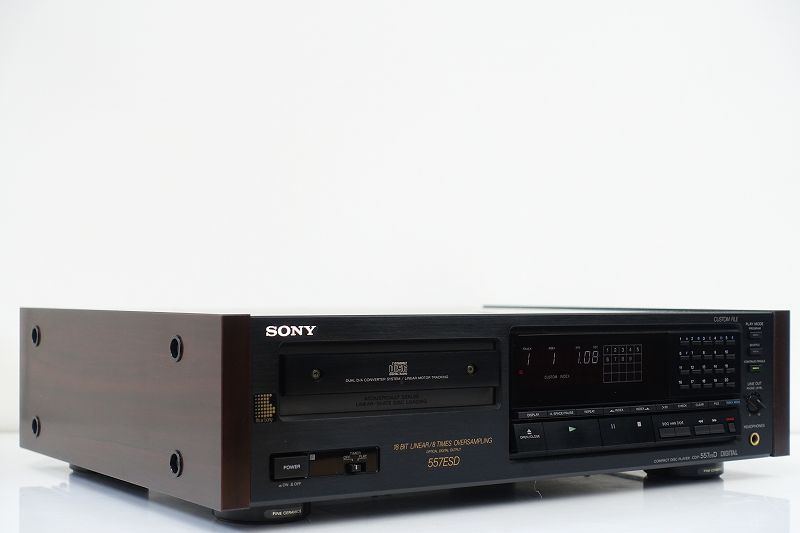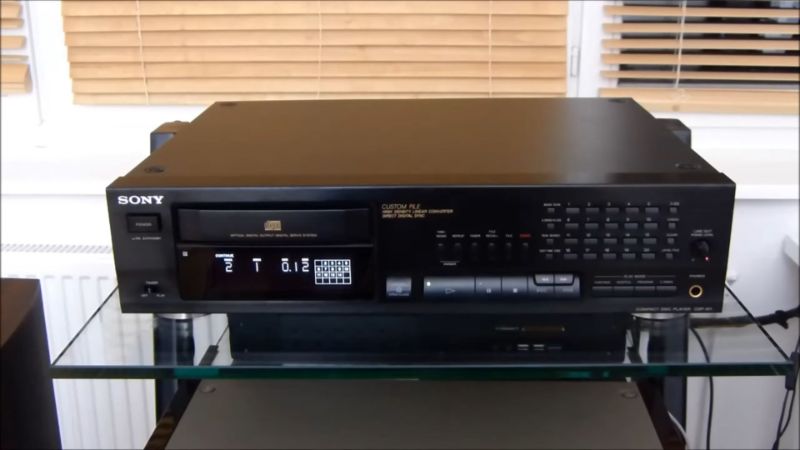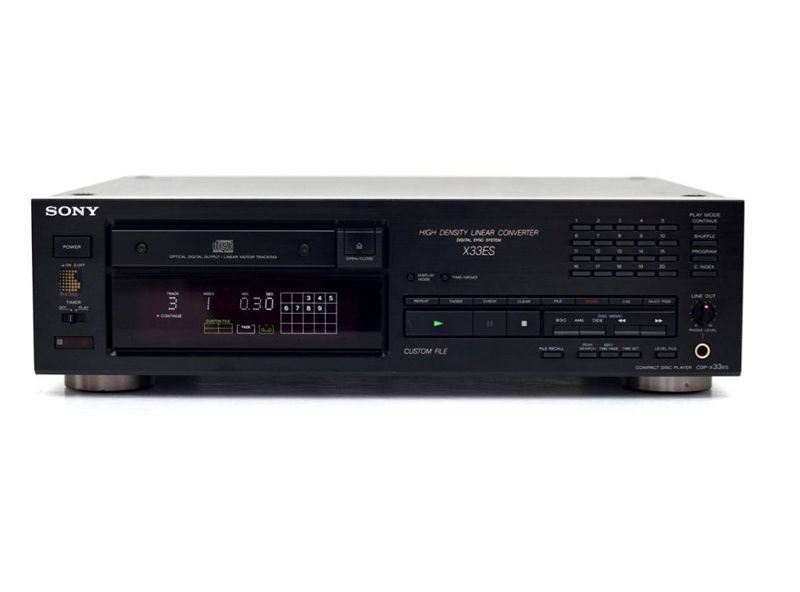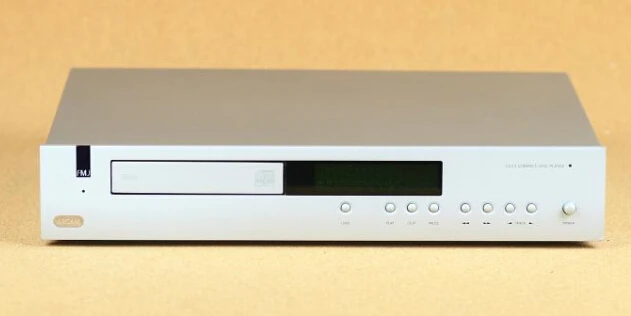For many years, the name Marantz has been connected with hi-fi. Saul Marantz founded the company in America, and it immediately gained a name for its valve amplifiers, among other things. The company has long been associated with the massive Philips corporation, but despite reaping significant benefits from that association, not least in recent years from Philips’ experience as co-inventor (with Sony) of the Compact Disc format, it continues to operate independently in most areas. However, it does share some design and even product ideas: for example, many readers will be aware with the original Philips CD 100 top-loading Compact Disc player or its Marantz counterpart, the CD63. Marantz has its own design team that collaborates with the European Philips R&D labs while also working independently.
The CD-94 is the Marantz equivalent of John Borwick’s evaluation of the Philips CD960 from May. It, like that model, is the range’s flagship and commands a correspondingly high price. Although many of the technical and operating elements are similar, they are also significantly different, an individuality that is maybe externalized by the vastly varied approaches to cabinet design and control arrangement. The Marantz CD-94 has a very tidy and logical front panel layout. At first sight, the disc-loading drawer open/close, FTS (favorite track selection), track up and down, play, pause, and stop buttons appear to be the only controls visible. A full-width flap at the bottom of the fascia covers the second level functions, in a sense.
There’s a timer function switch (the machine can be set to start playing right away), ten numeric programming buttons with select, memo, cancel, and recall, a headphones socket with adjacent level control, time display (track elapsed, track remain, or total remain time), shuffle mode (plays the tracks in random order), A-B repeat (cycles between two user-chosen points), repeat (of disc, track, or programmed selection), and AMS (automatic music search—
The display includes a 24-track ‘calendar’ that shows which tracks have yet to be played, as well as track number, index number, and time (which is helpful with a programmed sequence). The FTS feature is a now-familiar programming trick that allows the machine to save favorite tracks from up to 226 discs and automatically remember the appropriate ‘menu’ each time a disc is inserted (the memory for this being held even with the power oil). The numeric buttons offer direct track access, which is the shortest way to get to a certain point on a disc, in addition to supporting the standard variety of programming options. The initial access time is roughly four seconds, which is sufficient but not as quick as some machines. Except for shuffle, all of these operations are duplicated on a pretty ordinary-looking infrared remote control.
Six sockets, five of which are gold-plated phonos, are located on the back panel. There are two digital connectors, one electrical and the other optical (Toshiba type), providing proper connecting with external digital-ready equipment in addition to the standard analogue outputs (fixed level only). Only when the Marantz CD-94 is connected to a Marantz “Bus Control” system do the remaining two plugs come into play. The main chassis, as well as the laser transport subchassis, are made of die-cast aluminium and sit on hefty rubber mountings for vibration resistance. A single-beam laser is used, which is mounted on the same simple swinging arm carrier that has previously served Philips and Marantz machines well. The case is made of aluminium and has beautiful lacquered wood side panels.
The TDA 1541, a Philips 16-bit digital-to-analogue converter integrated circuit, is used in the Marantz CD-94, along with four times oversampling. This method, which is becoming standard in high-end machines, provides excellent digital bit stream resolution, with the 176-4kHz sampling rate (four times the basic CD rate of 44-1kHz) improving accuracy and allowing the use of considerably milder analogue output filters (third order Bessel types here).
Low order filters are advantageous, partially due to their simplicity and low in-band phase shift, and partly due to the fact that they are less prone to ringing on transient waveforms than high order “brickwall” filters. Because the TDA 1541 contains two completely distinct D/A converters on one ‘chip,’ the two stereo channels can be processed simultaneously rather than sharing the same converter with the related II -3t.sS inter-channel delay (which in itself is probably irrelevant but by avoiding it the question is skirted). Throughout the circuit, high-quality components are used.
The Marantz CD-94 is a standalone player in the traditional sense, but either of its digital outputs can be connected to a digital processor unit (such as a tape recorder or one of the new digital-ready amplifiers) or a separate D/A converter. The Marantz CDA-94 is Marantz’s own version of the latter, designed specifically for use with this player.
When used in this manner, the player becomes half of a two-box system, similar to the Sony CDP-552ES/DAS702ES combo evaluated in January 1986. It, like that set-up, aspires to be an audiophile. The Marantz CDA-94 is designed to look exactly like the Marantz CD-94, and it even has the same cabinet and subchassis. It includes three digital inputs, one optical and the other two electrical, as well as a send (record out) and return (monitor) for a digital tape unit. Two small rotary switches located behind the front panel flap regulate input and monitor switching.
As before, a headphone jack is included, along with a level control. An absolute phase switch and a big knob that regulates the level from one of the stereo analogue outputs are the only additional controls. The CDA94 supports automatic sample rate switching, which means it will choose the appropriate parameters for 32, 441, or 48kHz inputs and process them appropriately.
The display is straightforward, showing the selected input, tape monitor status, and sampling rate. The phono sockets for the two electrical inputs and recorder signals, as well as a Toshibatype fiber-optic connector, are located on the back panel. There are three pairs of analogue stereo outputs: fixed and variable level unbalanced phono connectors, as well as professional XLR Type X2 balanced (fixed level) at 600 Ohms. The Marantz CDA-94 plainly takes a no-compromise approach on the inside. There are three mains transformers: one for the digital input/output part, one for the D/A converter section, and one for the analogue section. Each of these is constructed on its own circuit board with high-quality components and is heavily insulated.
Absolute phase refers to whether the loudspeaker cones move outwards or inwardly in response to a specific impulse. Some people appear to be sensitive to this discrepancy, and the actuality of the signal appears to be amplified or reduced as a result. Because most users have no means of knowing how many phase inversions have occurred along the signal’s complicated trip from microphone to loudspeaker, some provision for altering it “to taste” can be useful.
As a side note, the diagrams in the brochure and on the player show that this switching happens after the analogue filters, although the brochure text states it happens in the digital domain… But not that it matters.
On its own, the Marantz CD-94 delivered the impressive performance I had hoped for, having previously known and owned players from this stable. It breezed through all of JB’s testing, proving that this is Marantz’s greatest player yet. Perhaps impressive is the incorrect word, because the sound is notable more for what it lacks than for what it does have. It lacks any sort of treble emphasis or the grittiness that some listeners associate with digital sound, and it doesn’t appear to have any type of auditory character of its own.
The output is as smooth and detailed as the source signal, with a genuinely intact and solid stereo soundstage. It’s a non-fatiguing sound that encourages long-term listening, and its subtlety necessitates some time before these attributes become completely apparent. The CD94 is pricey at £799, but it is well built, sounds fantastic, is sympathetic to tough discs (unimpeachable tracking of our ‘defect’ test disc), and is a joy to use. It’s difficult to define what you get for an extra £799 spent.
Of course, the money may be better spent if a DAT recorder is also connected; then, the system would share a D/A unit of established quality. The test bench findings were excellent once again, with excellent signal-to-noise and crosstalk values. On the surface, the Marantz CDA-94 adds only a volume control and an absolute phase switch to the Marantz CD-94, but attentive listening reveals other refinements to the overall audio performance. The coaxial electrical link or the fiberoptic coupler can be used to connect the two devices.
The differences are even more subtle here, and while I prefer the latter, it’s difficult to believe that this is due to anything other than a quirk of the grounding arrangement that it overcomes (the machines’ chassis are ‘tied’ together with the coax connector, whereas the optical coupler keeps them separate). It should perhaps be emphasized that while doing such sensitive A-B comparisons, it is critical to ensure that both absolute phase and level agree exactly. If that fails, the subjective results are just untrustworthy. The standard method of level matching by ear is insufficiently sensitive.
There is a greater sense of resolution with the Marantz CDA-94 in circuit. Small subtleties that had previously been heard – Bows on strings, fingers on fingerboards, tonguing noises on a reed, and so on – are now even more discernible. The atmosphere created by a well-recorded ensemble is more palpable. It’s as though another thin veil has been lifted between artist and audience, to borrow a cheesy cliché.
All but the most proficient ancillary equipment would mask this level of refinement, but for the audiophile whose £1,600 CD player matches a suitably configured system, it may be substantial, and the Marantz CD-94/Marantz CDA-94 combination should be heard at any rate. The lone £800 Marantz CD-94, which sits among the top players now available, would more than suffice for most of us.







